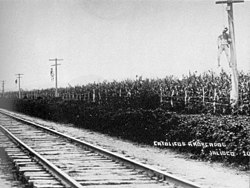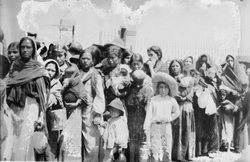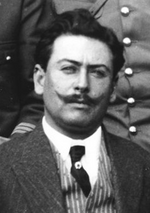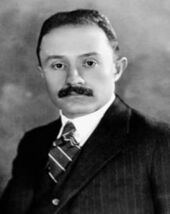Sotirian State of Marirana
Sotirian State of Marirana Stato Sotirico d'Marirano | |||||||||
|---|---|---|---|---|---|---|---|---|---|
| 1905–1936 | |||||||||
| Motto: Dio, Patria, Tradizione God, Fatherland, Tradition | |||||||||
| Anthem: Divina Patria | |||||||||
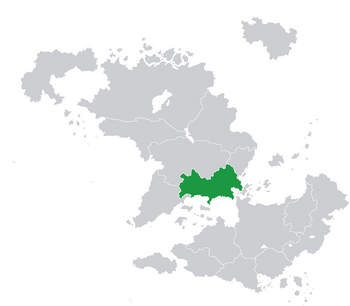 | |||||||||
| Capital | Aquinas | ||||||||
| Common languages | Etrurian | ||||||||
| Religion | Solarian Catholic Church | ||||||||
| Government | Integralist corpratist one-party dictatorship | ||||||||
| Duce | |||||||||
• 1905-1936 | Ottaviano Castello | ||||||||
• 1936 | Enzo Sanmartino | ||||||||
| Legislature | Assembly of Clergy and Corporations | ||||||||
| History | |||||||||
• Establishment | 17th July 1905 | ||||||||
| 1905-1907 | |||||||||
| 1908-1913 | |||||||||
| 1927-1936 | |||||||||
• Disestablished | 18th March 1936 | ||||||||
| Population | |||||||||
• 1906 | 12,000,000 | ||||||||
• 1916 | 14,000,000 | ||||||||
• 1926 | 22,500,000 | ||||||||
• 1936 | 23,587,000 | ||||||||
| Currency | Lira | ||||||||
| |||||||||
| |||||||||
The Sotirian State of Marirana (Vespasian: Stato Sotirico d'Marirano) was the state that ruled Marirana from 1902 to its dissolution in 1936. Dominated by Duce Ottaviano Castello the Sotirian State was a one-party dictatorship under the far-right Integrated Union of the Traditionalist Right.
The Sotirian State emerged following Red December and the 1902 presidential election which saw the rise of military officer Ottaviano Castello. Castello subsequently undermined Mariranan democracy abolishing political parties, creating a secret police force the Bureau for the Defence of the Fatherland (commonly known as the Uditria) and eventually abolishing the Free State creating the Sotirian State. The Sotirian State was based on the principles of integralism corporatism, national Catholicism and authoritarianism.
Upon coming to power Castello led the White Terror killing or imprisoning over 300,000 political opponents, turning Marirana into a totalitarian state. Censorship was imposed and a cult of personality around Castello was constructed, presenting him as a semi-monarchical figure.
The government imposed corporatist economic policies in place of the then existing laissez-faire model as well as embracing autarky over free trade. Whilst there was industrial growth, the policy of autarky resulted in a famine known as the "Great Hardship" from 1908-1913 which saw the death of between 500,000-2 million people. The government also launched evangelisation and ethnic cleansing plans to downplay and remove the native aspects of Mariranan culture.
Whilst initially striving for a neutral foreign policy following the rise of Gaullica's National Functionalist regime Castello pivoted to back a clear pro-Gaullican foreign policy whilst exhibiting revanchist goals over territory Marirana had historically lost to Roeselle. Marirana sided with the Entente during the Great War where with assistance from Satucin they led invasions into Roeselle and Asteria. Marirana however was unable to win the conflict and was by 1936 occupied by Alliance forces resulting in the Sotirian State to be dissolved in 1936.
History

Castello's seizure of power
Since 1884 Marirana had been ruled by an oligarchy of republican military officers, southern industrialists and coffee farmers' supported by the Asterian Cocoa Company with the government supporting anti-clerical, free trade and federalism. An attempt to appropriate Asterian cocoa plantations under President Joaquim Durão de Azevedo in 1897 resulted in Asteria to invade Marirana and install a more friendly government under Serafino Minuto-Rizzo. Political instability however continued with Minuto-Rizzo's successor Luigi Balsamo being assassinated in 1903. In mid-1904 a dispute over land ownership in northern Catacosi led to peasant uprising across Asterian-owned plantations. President Giovanni Lombardi requested Asterian military assistance which helped put down the uprising (known as the Catacosi Mission in Asteria).
In both the Cocoa War and the Catacosi Incident a lieutenant general, Ottaviano Castello, had become a national hero for his military exploits having defeated Asterian forces in the Battle of Fort di Maria during the Cocoa War and effectively repressing peasant unrest in Ritaldi during the Catacosi Incident, utilising a militia group known as the Front for the Defence of Marirana (FDM). Castello's charisma and well cultivated relationship with both the clergy and the Conservative Party meant he soon became the dominant figure of Mariranan right-wing politics.
In 1905 Castello consolidate the Conservative Party and the FDM into a new organisation, the Integrated Union of the Traditionalist Right (UIdDT), to contest the election that year. Elections under the Liberals had been for the most part uncontested due to the well entrenched practice of electoral fraud and traditionally high levels of political violence. The creation of the UIdDT was less of an electoral vehicle but more a concentrated by conservative sections of the military and the church to concentrate support for Castello and set the groundwork for a body to later seize power.
Predictably the liberal candidate, Ettore Carozza won the 1905 election with an implausibly high 80% of the popular vote and secure the entirety of the electoral college. However Carozza never took office - on the 20th February Mariranan officers stormed the presidential palace, imprisoning president Lombardi whilst using artillery to shell the national congress. Castello declared himself the legitimate president, stating Carozza had only won the 1905 election due to electoral fraud and that he would endeavour to oversee a return to normalcy in the state.
Consolidation of power
As Castello was supported by a loose heterogeneous coalition of right-wing groups who had differing aims, Castello's assumption of power prompted these groups to start jockeying for power. Right-wing liberals and moderate conservatives wished to restore a business friendly, anti-socialist government, whilst more reactionary elements of the conservatives alongside the clergy aimed for a theocratic state or the retention of presidential dictatorship. The FDM wanted a radical national syndicalist state and the armed forces a military dictatorship.
Castello's response to his weak political position was to appoint a broad section of moderate conservatives and right-wing liberals to his cabinet whilst ensuring military officials such as Amedeo de Rossi occupied roles such as Army and Interior Ministers. One of the first acts of the Castello government was to organise a rural police force, the Department for the Repression of Banditry (DRB), ostensibly to ensure peace in the countryside but which in reality had already begun rounding up political opponents and executing them. Castello also dismissed the entirety of the Supreme Court for being pawns of the Liberal party and appointed loyal judges.
This move led to the moderate faction of the UIdDT to withdraw support for Castello. In response to this Castello with military backing forcibly dissolved the national congress and called an election, which was neither free nor opponents. Liberal and moderate conservatives were beaten at polling stations with voting being held in public. This resulted in the UIdDT to score a landslide supermajority taking almost every seat in congress. With his hand strengthened, Castello dismissed moderates from his cabinet and filled it with loyalists. Having control over the executive, judicial and legislative branches of government Castello on the 30th July 1905 passed the dissoluzione decree which abolished much of the institutions of republic and created the Sotirian State of Marirana, a single-party Catholic dictatorship centred around Castello.
White Terror
The new regime upon taking power faced numerous opponents - loyalists to the fifth republic, liberals, the nascent socialist, anarchist and cooperativist movements; Protestant Sotirians, freethinkers and intellectuals; and native peasants. As well as this, Marirana's neighbours - most prominently Roeselle - were wary of the new regime due to a worry of the possibility of a revival in revanchist sentiment in Marirana. Partly as a strategy to consolidate his own power Castello declared in July 1905 that another peasant uprising "fuelled by socialistic atheism imported from Marolevia" was imminent and that the DRB would be deployed to "root out subversive activity". By framing this repression as preventing a potential peasant uprising - similar to the one that occurred in 1904 - Asterian cocoa companies gave cautious support to the new government.
The announcement of measures to curb this supposed peasant rebellion is commonly seen to be the beginning of the "White Terror" in Marirana. With the support of the Solarian Catholic Church who justified repressive measures on the basis Castello was defending Sotirianity and endorsed a national crusade against "the vices of republicanism, liberalism and socialism" Castello ordered the DRB - now numbering one thousand members, organised in forty-two squads - to enter cities, towns and villages to root out enemies of the state. According to Massimiliano Travaglio, who would later become head of the DRB, "the masses are no better than animals and you can't expect them not to become infected with the virus of socialism and atheism. After all, rats and lice carry the plague. Our duty is simply to clean the nation of disease". There was a concentrated effort by the church, landowners and the military to dehumanise those of lower social standing (peasants and the growing working class).
A contemporary Asterian journalist, Pierre Compère-Morel, described the modus operandi of the DRB as the following after visiting the country in 1906 -
"A band of these so-called anti-banditry brigades - usually brutish men with hard faces and cruel eyes - would enter a village or a town. They would immediately gather the local clergymen to identify who was they would call a traitor where they would go around houses, dragging out those who the priests stated were enemies of the state or God. Of course they would often "widen" these searches to find others who fitted the description. These poor souls would be hauled into the town hall, where they would be subject to the most dreadful torture to "cleanse them of their sins". One would of course be unable to see this torture, but you would hear the animal like howls that accompanied them throughout the night. It would be the next mourning when the church bells would ring and these people were brought into the town square. You could see now their missing fingers, their teeth rearranged, their bloodstained scalps. They would then be shot in front of the town into a pre-dug pit, and the townsfolk told to bury the bodies. If you refused, you too would be shot. The men would than mount their horses and move onto the next town."
Higher ranking dissidents, including former liberal politicians such as Ettore Carozza, were formally tried in military courts where they were often sentenced to death. In March 1906 in order to formalise the structure of repression Castello ended the DRB's indiscriminate raiding of towns instead setting up 6 concentration camps around the country. In these camps human experimentation - especially relating to the idea of "atavistic born criminals" - was common, with lobotomy particularly embraced in order to "remove socialistic, atheistic influence" from the populace. Babies were also confiscated from their mothers to be adopted by families designated patriotic Sotirians or placed in the hands of the church.
The White Terror was eased slowly between 1907-1910 as many of the real and imagined opponents of Castello faded from the political scene and the regime became secure. In 1910 Castello ordered for the concentration camps to be converted into conventional prisons as the states repressive mechanisms had become effective in of themselves in suppressing dissent. Its estimated between the 1905-1910 period 60,000-100,000 people died as a result of the White Terror.
Autarky
Castello came to power in Marirana in the context of an economic depression. The start of the Asterian Civil War in 1904 had disrupted Marirana's export-orientated economy, which was reliant on access to the Asterian market, with the Asterian-owned cocoa and oil companies in particular redirecting investment from Marirana in order to protect their assets in the case of a spillover from the war.
Although largely ignorant of economics, Castello in the conservative tradition was sceptical of the lassiez-faire export-orientated model the Liberal party had built up over their rule. Castello appointed as his principal economic advisers a group of bureaucrats, military officials and industrialists led by Tommaso Andrello who advocated a series of ambitions policies that sought to industrialise and modernise the Mariranan economy at a rapid rate. These ideas of modernisation were backed by the military, state bureaucrats and the rapidly growing urban bourgeois groups, whilst being opposed by rural based landowners and Asterian companies. Many within the government saw the Asterian civil war as the opportunity to undermine Asterian interests and build a new economy in its place.
In June 1905 the government began a programme of economic stimulus, investing in public work programmes the most notable of which concerned the development of a railway between Aquinas and Santa Maria. The government also imposed import quotas to expand the domestic industrial base, moving away from the free trade model and towards a protectionist system of import-substitution industrialisation. These policies of public investment and economic development led to growth to return in 1906, vindicating the military-bureaucratic alliance and undermining the influence of landowners.
With economic growth returning and Asterian civil war worsening, in March 1907 Castello signed a decree expropriating foreign-owned resources in Marirana, targeting Asterian companies in particular. This move caused outrage in Asteria with the Asterian government formally calling for a boycott of Mariranan goods. Between 1907-1909 the Mariranan government and Asterian companies entered negotiations to secure compensation - the Mariranan government was able to persuade Asterian shareholders to accept a below-market price for the nationalised resources, secured due to the civil war still raging in Asteria and on the basis that the expropriation could not be undone, since Castello's position and the position of the newly nationalised resources were secure.
The boycott of Mariranan products however led to the government to inwardly focus development and increasingly abandon the export market, embracing the idea of autarky, an idea heavily advocated by the military who believed only by being self-sufficient in its needs could Marirana become a great power. Although Marirana would continue to engage in limited trade with other nations after 1907 it increasingly began to embrace autarkic policies.
Great Hardship
The "Great Hardship" (grandi difficoltà) was the term officially used by the Mariranan government to describe a widespread famine that occurred in the country from 1908 to 1913. It was caused by a series of government policies that have been widely seen as being purposefully hard towards the rural, indigenous population.
Incompetent management under the Asterian companies had already rendered the agricultural sector by the early 20th century as being stagnant and having difficulty accommodating an increasingly large rural population. Thus there was a long-term decline in the per capita availability of food and growing numbers of land-poor or landless peasants, of which a high proportion also laboured beneath a chronic cycle of debt that ended in debt bondage and the loss of their landholdings due to land grabbing. When Asterian assets were nationalised by the Mariranan government much of it was rural and worked on by indigenous people's whose legal status under the Asterian plantation owners were little better than serfs. The new land was quickly privatised to Mariranan landowners but under an understanding that the land was to incorporated into the government's industrialisation programme and indicative planning measures in order to satisfy the regimes corporate sponsors.
In 1908 following the boycott of Mariranan goods and the turn towards autarkic trade policies Marirana drastically cut the amount of food imported into the country. The industrialisation programme also led to the government to incentivise farmers' to migrate from rural areas to cities to become industrial workers', depriving the countryside of manpower needed to address agricultural shortfalls. The government also imposed a series of quotas for farm yield to be exported at below-market prices to the few states that still traded with Marirana as well as to feed the growing urban population.
These policies collectively resulted in agricultural production to collapse in 1908 with starvation across villages being widely reported due to the majority of agricultural product being moved to cities. The government responded by introducing price controls on grain and attempting to impose rationing, but this only resulted in the growth of a large black market. In 1909 the price controls were removed but this only resulted in widespread hoarding.
The government at first denied the existence of undernourishment in rural communities, dismissing foreign reports of famine. However already by 1909 the government purposefully contained the famine in areas inhabited by indigenous people. When rationing was introduced it was conditional on those receiving it to speak Vespasian and be Solarian Catholic - this effectively excluded native people's, who also saw their language banned and grain purposefully taken from native areas to feed urban areas. Because of this the famine has become to be seen as a genocide against the native people of Marirana.
By 1912 the famine had started to dissipate. The threat of a food crisis in cities meant that the government created the National Food Distribution Bureau which assigned food rations on a more equal basis, extending rationing to native peoples. As well as this the end of the Asterian civil war and boycotts on Mariranan goods meant the country began to import food again. Officially malnourishment ended in 1913, albeit cases of it persisted in some native communities throughout the 1910's and 1920's.
It is estimated 500,000 to 2 million people died as the result of the Great Hardship.
Alliance with Gaullica
The end of the Great Hardship saw a gradual dismantling of the autarky policy. However in an unexpected move rather than re-align to Asteria Castello began to cultivate strong relations with Gaullica, starting with a preferential trade treaty in 1914. There were several reasons for this alignment - Castello was a strong Gaullophile perceiving the country's Catholic heritage constituted the "peak of human civilisation" against the liberal decadence of Asteria and Estmere. As well as this with Gaullica's colonial holdings in Satucin, Senouillac and Sanslumiere made it a rival for Asterian influence in the region, something Castello hoped to capitalise on.
From the 1914 to 1919 Gaullican influence in Marirana was mainly economic in character, with Gaullican companies investing in Mariranan industry and infrastructure, particularly railways some of which were privatised to these companies. Industrial development during this period was considered to be impressive as the government utilised a mix of indicative planning, protectionism to key industries, foreign investment and a controlled export regime to direct towards the creation of factories. Technological development mainly in the field of military research was pursued, such as the creation of the Massilimo rifle, the Octavio R17 (and its successor the Octavio R20 and the joint Gaullican-Mariranan venture the Étienne Massilimo gun. Marirana also began to purchase military equipment from Gaullica albeit not on a large scale.
The rise to power of the Parti Populaire under Rafael Duclerque in Gaullica in 1919 led to a change in Mariranan politics. Castello's mix of integralism, political Catholicism, anti-socialism and ultranationalism had already drawn comparisons with Duclerque's Functionalism with some considering Castello to be a "proto-functionalist. In 1920 Castello reshuffled his cabinet, appointing Alessandro Fico and Sebastiano Osio to become Minister of Foreign Affairs and Minister of Information respectively.
Fico and Osio had close links to the Gaullican regime and sought to give Castello's government a greater degree of ideological rigour. Both ardent functionalists, Osio attempted to combine Castello integralist state with functionalist doctrines, coining the term "functionalist integralism" to describe the Mariranan state. Bureaucrats were at times replaced with far-right priests in order to "clericalise" the regime on integralist lines.
Meanwhile as foreign minister Fico saw a shift from a non-interventionist to a more activist foreign policy. Far-right leaders in the Asteria's whose regimes resembled Castello's - such as Henri Masson in Satucin, Laurens Wispel in Nimear and Augusto Octavio Assunção in Moreira - became key allies to Marirana, with economic, political and military ties being increased. Fico also began to press Mariranan territorial claims in Roeselle and Duquesne and framing Asteria as a "harbinger of godless Protestantism, capitalism and liberalism on the continent".

In 1920 Fico was able to secure a military mission from Gaullica, who sent General Guillaime de Learé to Aquinas to advise the Mariranan army on modernisation. De Learé in cooperation with Inspector General of the Mariranan army Enzo Sanmartino published a report that envisioned a massive reform of the army. De Learé recommended that the army be based around a core of 25 highly trained, well-equipped divisions (5 mechanised, 10 cavalry and 10 infantry/artillery) with a reserve force based around the Guardia Rurale, an already existing auxiliary force. De Learé stated that in any war with Roeselle or Asteria the Mariranan army would have to rely on securing a quick victory taking advantage of terrain, disorientating the enemy army and cutting them off from supply lines in order to prevent a complete mobilisation of enemy forces. The Guardia Rurale would function either to occupy enemy territory after the main army had defeated the enemy or would act as guerrilla fighters in Marirana itself was ever occupied. The general direction of de Learé recommended reforms were to create an army focused on speed and offensive warfare and if that failed policies intended to deter an effective occupation at any cost.
Castello enthusiastically embraced de Learé's recommendations after Sanmartino lobbied to have them adopted. Sanmartino as Inspector-General implemented much of the reforms, reducing much of the 40 division large army and purchasing trucks and tanks from Gaullica, mainly FT15 light tanks. The Mariranan high command at this point - dominated by Castello, Sanmartino and general Giancarlo Castello, Castello's nephew - agreed with foreign minister Fico's bellicose foreign policy believing that a war to reclaim former territory in Roeselle was necessary to secure Marirana's future. Political inertia coupled with a stuttering economy meant Roeselle was at this time not seen as a threat by the Mariranan high command, who reasoned that by testing de Learé's doctrines in the country would best prepare Marirana for a future war with Asteria. The government also began to research and develop chemical and biological weapons with the intention to use them to ensure any occupation of enemy territory resulted in zero resistance.
The 1924 at the urging of Fico Castello oversaw the signing of the Treaty of Découverte alongside Wispel, Masson and Octavio Assunção which formally inducted Marirana into the Entente military alliance and Gaullica's sphere of influence. By this point Marirana was seen by Estmerish and Weranian foreign policy experts as a de facto satellite state of Gaullica with Gaullican influence penetrating all forms of political, military and economic life.
Great War
Invasion of Roeselle
Expansion of the war
Defeat
Government
The Sotirian State was an autocratic regime built around the figure of Ottaviano Castello who served as leader of the government, military and the sole legal party the Integrated Union of the Traditionalist Right (UldDT) which respectively served as the executive, coercive and ideological arms of the state. The government was operated on a "pyramid" model in which Castello as Il Duce was at the "apex" of the pyramid and delegated power to other organs that were reliant on his authority.

The Sotirian State did not possess a codified constitution. The dissoluzione decree of 1905 served as a de facto governing document, stipulating that the head of state was the Duce and that the previous organs of state were permanently dissolved. Further decrees outlawed political parties, created the Assembly and stipulated that the UldDT was the single legal political party. The post of il Duce served as the head of state and the head of government heading the executive and serving as commander-in-chief of the military. The Duce was elected in a "popular consultation" every five years - voters would be asked to approve of extending Castello's term by five years in a yes/no referendum. This was the only election that took place in the Sotirian State, and voting was done in public; those who recorded a no vote would often be subject to negative repercussions. The legislature was the Assembly of Clergy and Corporations which consisted of appointed clerics and the heads of the national corporations designed by the government. The Assembly was a purely advisory body and only met once a year. All members of government were required to be members of the UldDT.
In practice governance was exercised by two entities - the military high command and the official cabinet, which were both represented within the UldDT's Executive Bureau. Castello refused to appoint a military officer to cabinet after 1907 instead appointing technocrats to head ministries; however cabinet ministries often shared responsibility over certain matters with the military bureau's set up in 1906 to co-currently direct government affairs.
The system created as a result from this structure encouraged competition between military and civilian officials; ministers and bureaucrats were dependent on personal patronage with Castello to exercise effective power. This ensured that the system retained an autocracy as power laid ultimately with the personal authority of Castello.
Ideology
In a speech to the Assembly of Clergy and Corporations in 1907 Castello stated his government was based "on the principles of order, God and fatherland". The UldDT, which functioned as the ideological arm of the regime, had ideological basing in integralism, authoritarianism, national Catholicism, anti-socialism and anti-liberalism. Although his government was part of the Entente, historian Pat Cook states that Castello "is not in the academic sense considered a national functionalist, being perhaps better described as proto-functionalist."
Historian Carlo Gentolini stated that the Castello regime was "hardly an ideological monolith" pointing to the UldDT as being relatively heterogeneous in ideological terms and many government members straddling a wide range of right-wing thought. Whilst there were extreme members of the government who preached irredentist or ethnic nationalism such as foreign minister Roberto Fico others such as Finance Minister Alcidi Prodi were considered to be continuing the conservative tradition of former president Luigi Balsamo.
Military

The military of the Sotirian state was known as the National Sotirian Army (Esercito Nazionale Sotirico; ENS) and the Nazionale Marina. An airforce, the Nazionale Aeronautica, existed as a branch of the army after 1920. The military was considered one of the pillars of the regime, with its members swearing an oath to Castello and being under his command, whilst the general staff being seen as one of the most powerful political actors in the state.
Prior to the rise of the Sotirian state military spending already took up the majority of government spending importing weapons from the Federation and Gaullica. However under the former system the officer class was oversized, with officers being appointed on the basis of balancing between liberal and conservative factions rather than merit. Upon coming to power Castello and his conservative allies in the military purged the liberal officer class and began to focus on more meritocratic officer progression. Conscription was introduced for all males between the ages of 16-64 in 1914. The army consisted of a large amount of infantry and cavalry divisions, with the army based around offensive doctrines where cavalry played a central role. There was also a large auxiliary force, the Guardia Rurale (Rural Guard) who were designed to be a government-controlled paramilitary functioning in a similar manner to a military police force. In 1920 General Guillaime de Learé was appointed to head a Gaullican military mission to Marirana and officially oversee a reform of its army. De Learé recommended a wide-scale professionalisation, modernisation and mechanisation of the army focused on ultra-offensive doctrines based around a core of elite troops with highly trained officers. In this he was supported by the Inspector-General of the army, Enzo Sanmartino, who had long advocated for a smaller, more specialised army and had already began introducing more modern and innovative doctrines into the San Marco Military Academy.
The period between 1920-1926 saw massive reforms to the army overseen by de Learé and Sanmartino. Purchasing weapons from Gaullica the army became concentrated around a core of 24 well trained divisions - 4 motorised, 10 cavalry and 10 infantry. Although de Learé considered these divisions to be less vigorously trained than he originally envisioned they still were considered some of the best trained troops in the Asteria's. In his 1925 review of the Mariranan army de Learé commented that Marirana possessed an "innovative and highly skilled officer corps" but cautioned that "in terms of equipment the army is dependent on us to provide the equipment they need to pull off their ambitious doctrines" and that the Mariranan navy was a "non-entity".
During the Great War the Mariranan high command (led by Castello, Sanmartino and general Edoardo Montezemolo) sought to implement de Learé's ideas in full. During the Roeselle motorised units based around a small core of around 200 FT15 light tanks and 25 Char B1 heavy tanks acted as a spearhead breaking through enemy lines after sustained artillery fire whilst cavalry units taking advantage of the local terrain would encircle and cut off the enemy army from supplies allowing infantry divisions to overrun the entrapped enemy. These tactics were at first highly effective and allowed the Mariranan army to push deep into Roeselle between 1926-1929 with only minimal support from other Entente forces. This was replicated in Duquesne in 1929.
The invasion of Asteria in 1930 saw Marirana's army become de facto under the command of Gaullican officers. Whilst 1926-1929 had seen Marirana pull of significant military successes General de Learé's analysis - that Marirana would become militarily dependent on Gaullica - became correct. As the Entente began to register military defeats in Asteria throughout 1932 the Mariranan military became rapidly depleted as the economy could not sustain a long-term war of attrition. Montezemolo's appointment as Chief of Staff resulted in a more defensive-orientated strategy which undermined much of the reforms General de Learé and Sanmartino had pioneered.
During the war the Nazionale Aeronautica was dramatically expanded with a focus on fighter planes and a small amount of medium bombers. Many of the planes used by the Nazionale Aeronautica were Gaullican made albeit with some modifications by Mariranan engineers. Despite the keenness of Mariranan generals to develop the Nazionale Aeronautica into a large force with cutting-edge technology it mostly served in support roles for Gaullican aircraft in the region. The Nazionale Marina which consisted of a battlecruiser, several destroyers and a handful of submarines never was considered to be a significant part of the Mariranan war effort.
Military defections, mutinies and heavy losses meant by 1935 the army was a shadow of its former self, being unable to muster many divisions to defend against Asterian and Roessen troops. By the time of the Mariranan surrender the Mariranan army was functionally destroyed.
At the declaration of war Marirana had mobilised over 2 million soldiers into 5 field armies of 250,000 men, putting a significant strain on its at the time 30 million population. By the end of the war over 2.5 million men total had been mobilised into the Mariranan army. Mariranan sustained 2,337,000 causalities (of which 474,525 were killed) meaning 82% of those mobilised were causalities.
Equipment
The equipment of the Esercito Nazionale Sotirico developed from mainly being Asterian surplus equipment to a mix of domestic Mariranan designs and Gaullican imports from its creation in the 1910's to its defeat in 1935. Some Mariranan weapon designs (such as the Massilimo rifle, the world's first gas-operated semi-automatic rifle created in 1907) were considered to be innovative helping inspire later designs.
Starting in 1905 under Inspector-General of the army Ettore Massilimo there was a trend towards replacing the army's equipment (which mainly consisted of Asterian M-1865 rifles) with indigenous Mariranan designs. The first of these was the aforementioned Massilimo rifle which was originally manufactured in Etruria as Marirana lacked the indigenous armaments factories to engage in large scale production of the rifle. The government's industrialisation programme meant however by 1910 the Massilimo rifle was able to be mass-produced within Marirana, gradually replacing the M-1865 as the main gun of the ENS. Another early weapon developed was the Étienne Massilimo 75mm gun, an early example of cooperation between Marirana and the Gaullican company Étienne armoury.
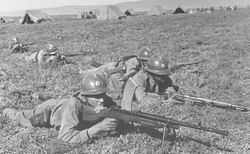
Later domestic innovations in Mariranan weapons came in the 1910's and early 1920's with the development of the Octavio R17 in 1926, a light machine gun which became standard issue in the Mariranan army, albeit the Guardia Rurale often still used Massilimo rifles or older M-1865's. The last major weapon developed by Mariranans during the Sotirian state period was the Octavio R20 light machine gun developed in 1933. Although intended to replace the R17 not enough R20's were produced for them to ever be widely used in the ENS.
After most Mariranan equipment was either solely Gaullican or based on Gaullican designs imported for use by the Mariranan army. The M26 helmet became standard issue for the Mariranan army after 1918, being painted to match the khaki tunics that constituted the regular armies uniforms. Other Gaullican equipment included the FT15 light tanks which became famous in their role during the invasion of Roeselle.
Despite the high hopes of the Mariranan high command, very little of the army was motorised or mechanised. Despite the infamous reputation of the Mariranan tank corps most of the fast moving units within the army were still on cavalry.
War crimes
